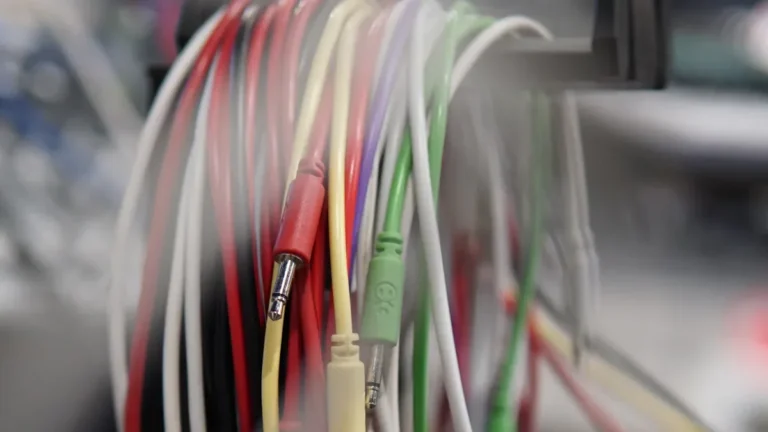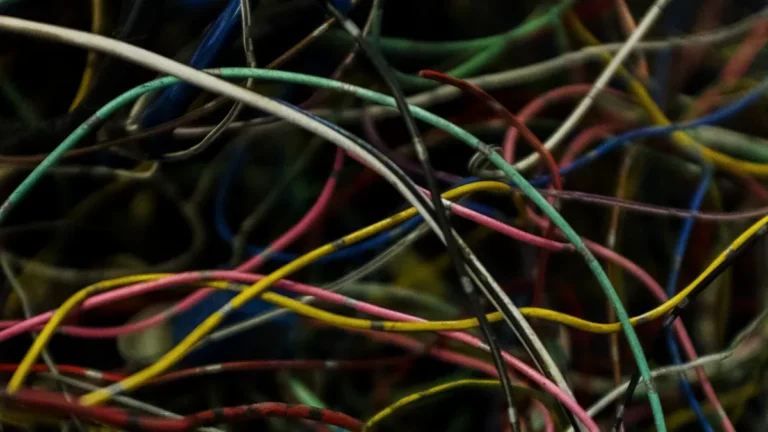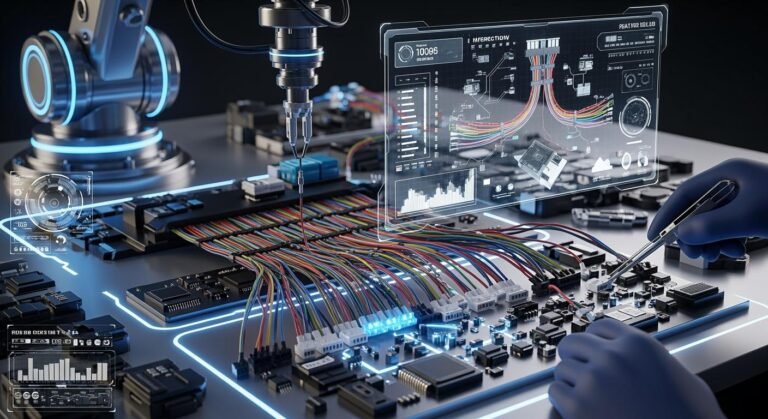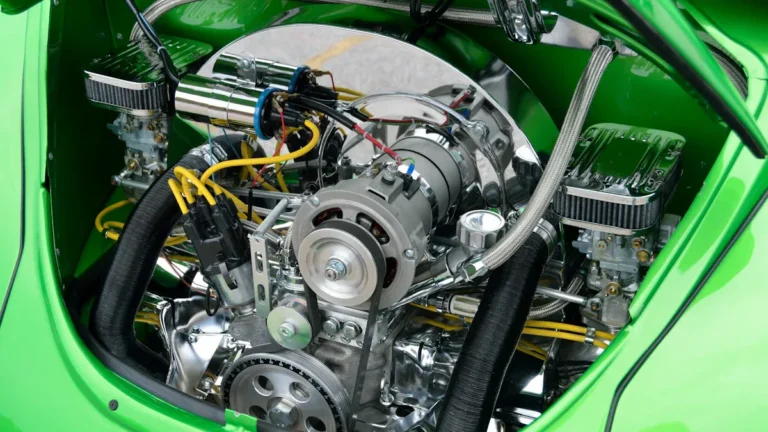Apa itu kelebihan perkakas dan bagaimana ia berfungsi di peralatan rumah

An Appliance Harness is a bundled wiring system found inside many home appliances. It connects different parts, delivers power, and allows parts to communicate. Manufacturers use high-quality materials like tinned copper and flame-retardant insulation to make the harness safe and reliable. Strict tests, seperti Glow Wire test at 750°C, help prevent fire hazards. The harness keeps wires organized and protected from heat, kelembapan, and vibrations, making appliances safer and more dependable—even as they become smarter.
Takeaways utama
An appliance harness bundles wires inside home appliances to connect parts and deliver power and signals safely.
High-quality materials and protective insulation keep wires safe from heat, kelembapan, and damage, making appliances reliable.
Harnesses organize wires neatly, which helps with easy assembly, quick repairs, and longer appliance life.
They support smart features by connecting sensors and communication modules, enabling appliances to work smarter.
Regular checks and proper design of harnesses prevent electrical problems and keep appliances safe and efficient.
Appliance Harness Basics

Definition
An appliance harness is a bundled set of wires and connectors used inside home appliances. This system organizes and protects the electrical wiring that links different parts of a device. Manufacturers use flexible, multi-stranded copper wires for most harnesses. These wires range from 0.5 to 6.0 square millimeters in size. The harness also includes connectors, terminals, and protective coverings like sleeves or tapes. These features help the harness fit into tight spaces and handle the movement or vibration found in many household devices.
Nota: Appliance harnesses appear in many devices, such as refrigerators, washing machines, air conditioners, and televisions. Each type of appliance uses a harness designed for its specific needs.
Typical Household Devices | Common Types of Harness Assemblies | |
|---|---|---|
Kitchen Appliances | Refrigerators, microwave ovens, ovens, rice cookers, blenders, juicers | Power transmission, signal transmission, interconnection between modules |
Cleaning Appliances | Vacuum cleaners, sweeping robots, washing machines, dryers, window cleaning robots | Power transmission, signal transmission, wiring harness for feedback components |
Air Conditioning Appliances | Air conditioners, electric fans, humidifiers, air purifiers | Power transmission, communication and coordination components |
Entertainment Appliances | Televisions, audio equipment, projectors, game consoles | Audio and video cable assemblies, interconnection harnesses |
Personal Care Appliances | Hair dryers, shavers, curling irons, beauty devices | Signal transmission, power transmission harnesses |
Main Function
The main function of an appliance harness is to connect different parts of an appliance and allow them to work together. The harness carries electrical power and signals between components like motors, sensor, switches, and control panels. This setup makes sure each part gets the right amount of electricity and can send or receive information as needed.
A well-designed appliance harness uses the right materials and structure to keep the appliance safe and reliable. Contohnya, copper wires provide strong conductivity and flexibility. Insulation materials like PVC or Teflon protect the wires from heat, kelembapan, and chemicals. Connectors made from thermoplastics ensure secure and stable connections. Some harnesses use special coatings to resist fire or water.
Component | |
|---|---|
Wires | Copper or aluminum; mis., UL1571-28AWG copper wire |
Penebat | PVC (environmental protection, super soft, tahan lama), Teflon |
Penyambung | Thermoplastics |
Special Coatings | Flame-retardant, moisture-resistant coatings |
The design of an appliance harness affects how well it connects and powers each part.
Fleksibel, multi-stranded wires help the harness bend and move without breaking.
Protective sheaths and insulation keep the wires safe from damage and prevent short circuits.
Secure connectors make sure the electrical flow stays steady, even if the appliance shakes or gets wet.
A good appliance harness reduces the risk of electrical problems, makes assembly easier, and helps the appliance last longer.
How It Works
Connecting Parts
An Appliance Harness acts as a bridge inside home appliances. It links the power supply to different components, making sure each part receives the energy and signals it needs. The harness bundles many wires together, keeping them organized and protected. This setup allows the appliance to work safely and efficiently.
Wire harnesses connect key parts such as motors, sensor, switches, and control panels.
They transmit both power and control signals between these parts.
The harness keeps wires in place, which prevents errors and reduces fire risks.
By organizing the wires, the harness makes the appliance easier to build and repair.
A modular harness design allows for quick maintenance and replacement, saving time and cost.
The harness connects many important components in household devices. The table below shows some common examples:
Component Type | Fungsi | Example Applications |
|---|---|---|
Control Panel & Mainboard | Connects control panel, mainboard, actuators | Microwave oven key panels, oven temperature control |
Sensors | Links sensors (temperature, humidity, pressure) | Air conditioner temperature control, refrigerator sensors |
Motors | Connects motors with controllers | Washing machine drum motors, vacuum cleaner motors |
Communication Modules | Supports device communication | Smart home appliances with Wi-Fi/Bluetooth |
Heating Elements | Connects electric heating tubes, PTC heaters | Electric water heaters, ovens |
Lighting Components | Drives LED or traditional lighting | Refrigerator lights, microwave oven lighting |
Independent Modules | Connects separate modules inside appliances | Refrigerator compressor, indoor/outdoor AC units |
A well-designed Appliance Harness increases reliability and helps the appliance last longer. It also makes the design and manufacturing process simpler and more efficient.
Power and Signal Transfer
The Appliance Harness does more than just connect parts. It also ensures safe and stable transfer of power and signals. This process involves several important steps:
1. Engineers design the harness, planning wire lengths, penyambung, and paths. 2. Workers cut and strip wires to the right size, exposing the metal for connections. 3. They attach terminals to the wire ends using crimping or soldering. 4. Wires with terminals go into connectors, following the planned layout. 5. The wires are bundled and secured with sleeves or tape for protection. 6. The finished harness goes through testing to check for safety and performance.
Inside the appliance, the harness acts as a communication bridge. It connects isolated circuits, allowing current to flow and signals to pass between parts. Contohnya, in a washing machine, the harness links the control panel to the drum motor, water level sensor, and door switch. In a refrigerator, it connects the mainboard to the compressor, temperature sensors, and interior lights.
The harness uses insulation and protective tubes to keep wires safe from heat, kelembapan, dan getaran. Secure connectors prevent loose connections, which could cause malfunctions. By keeping the wires organized and protected, the harness ensures the appliance works correctly and safely.
Appliance wiring harnesses are built to handle tough conditions. They keep power and signals flowing even when the appliance faces heat, kelembapan, or movement. This careful design supports the appliance’s operation and extends its service life.
Components

Wires and Connectors
Wires and connectors form the backbone of any wiring harness in home appliances. Manufacturers use high-quality copper or aluminum wires because these metals conduct electricity well and resist corrosion. Connectors join wires to different parts, such as motors, sensor, and control panels. These connectors often use thermoplastic materials that withstand heat and mechanical stress.
Wire harnesses can range from simple bundles to complex assemblies with many branches and connectors. Contohnya, the LG EAD61928104 Refrigerator Harness uses durable materials to ensure smooth operation of cooling and lighting functions. The WD21X21664 GE Dishwasher Wire Harness includes wire receptacles and connectors designed for easy installation and a perfect fit. These features help appliances run efficiently and make repairs easier.
Organized wiring reduces clutter and speeds up assembly. Color-coded wires and clear labels help technicians find problems quickly. This organization lowers maintenance costs and keeps appliances running longer.
Organized wires and strong connectors help prevent electrical issues, making appliances safer and more reliable.
Insulation and Protection
Insulation and protection keep wires safe from damage and prevent electrical hazards. Insulating sleeves cover each wire, stopping electricity from leaking out and causing shorts. Protective tubes shield wires from abrasion, vibration, and harsh conditions like heat or moisture.
Manufacturers use materials such as silicone rubber, fiberglass, Nomex, and PVC for insulation. These materials resist fire, chemicals, and high temperatures. Protective tubes made from polyethylene or polyamide add flexibility and strength. This combination keeps wires intact and working, even in tough environments.
Insulating sleeves and protective tubes also help bundle wires together. This reduces mechanical stress and keeps the harness neat. By protecting the wiring, these components lower the risk of electrical fires and extend the life of the appliance.
Component | Fungsi | Common Materials |
|---|---|---|
Wires | Conduct electricity | Tembaga, aluminium |
Penyambung | Join wires to appliance parts | Thermoplastics |
Insulating Sleeves | Prevent electrical shorts | Silikon, PVC, Nomex |
Protective Tubes | Shield wires from damage | Polyethylene, polyamide |
Labels | Identify wires for easy troubleshooting | Printed tags, color codes |
Insulation and protection are key to safe, cekap, and long-lasting appliances.
Benefits
Kebolehpercayaan
Appliance harnesses help home appliances work reliably every day. Manufacturers use strong wires and tough insulation to keep electrical connections stable. Skilled workers and modern machines cut and connect wires with precision, which reduces mistakes during assembly. Harnesses fit the shape of each appliance, keeping wires in place and lowering the risk of damage. Color-coded wires and clear labels make repairs easier and faster.
Kategori | Evidence Summary |
|---|---|
Harnesses connect motors, sensor, control panels in appliances like washing machines and refrigerators. | |
Safety Requirements | Compliance with fire protection and insulation standards, especially in damp environments. |
Durability Features | Anti-vibration, corrosion-resistant, and moisture-proof designs to withstand environmental stresses. |
Electromagnetic Shielding | Shielded harnesses prevent electromagnetic interference, ensuring stable appliance operation. |
Environmental Resistance | Weather-resistant harnesses for outdoor units withstand temperature extremes, rain, and UV exposure. |
Functional Benefits | Enable intelligent operation, fault detection, and communication between components, enhancing reliability. |
Harnesses also support smart appliances. They connect sensors, motors, and wireless modules, allowing devices to share data and work together. Shielded cables inside the harness block electrical noise, which keeps signals clear and appliances running smoothly.
Keselamatan
Safety is a top priority in every Appliance Harness. Manufacturers choose materials that resist fire, heat, and moisture. Insulating sleeves and protective tubes stop electricity from leaking and prevent short circuits. Harnesses often include flame-resistant coatings and fuses to limit fire risks. Waterproof designs protect wires in appliances like washing machines and dishwashers.
Proper wire sizing prevents overheating and insulation breakdown.
High-quality connectors stop arcing and keep electrical flow steady.
Mechanical protections like strain relief and overmolding guard wires against wear and movement.
Harnesses must meet strict safety standards, such as UL, CE, RoHS, dan ISO 9001. These rules ensure harnesses are safe, eco-friendly, and reliable.
If a harness gets damaged, appliances can suffer power surges, overheating, or even fires. Regular inspections and surge protectors help prevent these problems.
Maintenance
Appliance harnesses make maintenance easier for technicians and homeowners. Bundled wires reduce clutter inside appliances, so repairs take less time. Labels and color codes help workers find problems quickly. Pre-configured harness kits lower installation errors and speed up assembly.
Operators bundle wires with cable ties, tape, or sleeving for neatness.
Protective coverings shield wires from damage, which extends appliance life.
Advances in automation improve harness quality and consistency.
If a harness fails, moisture or chemicals can weaken insulation and cause electrical breakdowns. Overloads may heat wires and age insulation, leading to fires. Connector problems can reduce safety and cause accidents. Regular checks and proper use of surge protectors keep appliances safe and working longer.
Harnesses play a key role in smart appliances and IoT integration. They provide reliable paths for power and data, supporting features like remote monitoring and control.
Appliance harnesses help home appliances work safely and reliably. Manufacturers test harnesses with advanced equipment to meet strict safety standards. Consumers should look for strong copper wires, connectors that match the signal type, and coverings that protect against heat, kelembapan, dan getaran.
Check for certifications like UL, IEC, or CSA.
Choose harnesses with simple designs and proper wire routing.
Make sure materials resist corrosion and support smart features.
Trend baru termasuk 3D printing for harnesses, which allows for custom designs and better recycling. Smart home technology increases the need for harnesses that connect devices and save energy. Understanding harnesses helps users value the technology inside everyday appliances and make better choices for safety and maintenance.
Soalan Lazim
What is the main purpose of an appliance harness?
An appliance harness connects and organizes wires inside home appliances. It delivers power and signals to different parts. This setup helps the appliance work safely and efficiently.
Can a damaged harness cause appliance failure?
Ya. A damaged harness can interrupt power or signals. This problem may stop the appliance from working or create safety risks. Regular checks help prevent these issues.
How do manufacturers test appliance harnesses for safety?
Manufacturers use tests like the Glow Wire test and insulation resistance checks. These tests make sure the harness can handle heat, kelembapan, dan getaran. They help keep appliances safe.
Are appliance harnesses important for smart home devices?
Ya. Smart appliances need harnesses to connect sensors, control boards, and wireless modules. These connections allow devices to share data and support smart features.
Can homeowners replace an appliance harness themselves?
Most homeowners should not replace a harness without training. Appliance harnesses have many wires and connectors. Mistakes can cause damage or safety hazards. A qualified technician should handle repairs.






